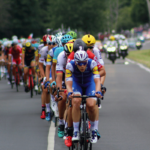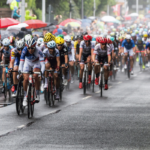Embark on a journey through one of cycling’s most prestigious and challenging competitions, the Vuelta a España. Held annually, this race weaves through the picturesque landscapes and rugged terrains of Spain, testing the mettle of the world’s elite cyclists. Discover the history, the heroes, the triumphs, and the heartbreaks that have defined this iconic event. Whether you’re a cycling aficionado or a casual fan, the story of the Vuelta a España promises to captivate and inspire. Join us as we delve into the essence of this remarkable race.
The Race’s Historical Origins
The Vuelta a España, one of cycling’s most prestigious Grand Tours, has a rich history that dates back to its inception in 1935. Conceived during a period of burgeoning interest in road cycling, the race was designed to increase circulation for the newspaper Informaciones, mirroring the marketing success of the Tour de France and the Giro d’Italia for their respective promoters. The initial race stretched over 14 stages and covered approximately 3,411 kilometers, a formidable challenge that attracted a blend of local and international riders.
Throughout the decades, the Vuelta a España has evolved, witnessing changes in route, timing, and competition format. Initially held in spring, the race moved to September in the 1990s to avoid clashing with the Giro d’Italia. This shift not only helped in attracting a wider array of international talent but also positioned the Vuelta as a crucial preparation race for the World Championships. The Vuelta’s route has been notorious for its grueling mountain stages, with the inclusion of the fearsome Angliru in recent years, testing the limits of even the most seasoned climbers.
The race’s ability to adapt and innovate has ensured its ongoing relevance and appeal. From humble beginnings to its current status as a key event in the professional cycling calendar, the Vuelta a España has remained a testament to the endurance, determination, and spirit of the cycling community. It continues to captivate fans worldwide with its challenging routes, breathtaking landscapes, and fierce competition.
Further Explorations into the Vuelta’s Past
Delving deeper into the origins and evolution of the Vuelta a España reveals the broader cultural and social impacts of the race. It has not only been a battleground for sporting excellence but also a mirror reflecting Spain’s changing societal landscape. The race has traversed regions rich in history and diversity, showcasing Spain’s varied geography and cultures to an international audience. It has also been a platform for emerging Spanish talent, fostering national pride and unity in the face of global competition.
Key Milestones in the Vuelta’s History
- 1935: The inaugural Vuelta a España is held.
- 1955: The race is broadcast on television for the first time.
- 1970s: Introduction of finish line sprints and time bonuses.
- 1995: The Vuelta moves from April to September.
- 2000s: Introduction of the Angliru, one of the most challenging climbs in professional cycling.
Key Stages and Mountain Climbs
The Vuelta a España stands out in the cycling world not only for its fierce competition but also for its grueling mountain stages that push riders to their limits. Among these, the ascent of the iconic Angliru, known for its punishing gradients, is a highlight that often proves decisive in the battle for the red jersey. Equally challenging is the climb up the Lagos de Covadonga, a climb steeped in cycling lore for its breathtaking views and the tales of heroism it has inspired over the years.
While the mountain stages are the most visually dramatic aspect of the race, the individual time trials also play a crucial role in shaping the general classification. The time trial stages are a test of both endurance and technical skill, with riders racing against the clock over rolling terrain that includes both flat sections and occasional climbs. These stages are pivotal in creating significant time gaps between the contenders and can often be just as decisive as the high mountain climbs.
The Vuelta’s route changes slightly each year, ensuring that the race remains unpredictable and exciting. The inclusion of new climbs and time trial routes keeps the competition fresh and challenges riders in new ways. The combination of steep ascents, technical descents, and strategic flat stages makes the Vuelta a España a comprehensive test of a cyclist’s abilities, endurance, and tactical acumen.
- Angliru – The Beast of Asturias
- Lagos de Covadonga – A Climb of Legends
- Time Trials – The Race of Truth
- Andorra Stages – High Altitude Challenges
- Picos de Europa – The Mountains of Dreams
Further Insights into Key Stages and Mountain Climbs
Delving deeper into the stages and climbs of the Vuelta a España, it becomes evident how these elements form the backbone of the race. The strategic placement of mountain stages towards the final week often turns the general classification on its head, making for a thrilling conclusion. The unpredictable weather conditions, especially in the mountainous regions, add another layer of complexity, testing the riders’ resilience and adaptability to the fullest. As such, the Vuelta not only showcases the physical prowess of the cyclists but also their mental fortitude and tactical intelligence, making it a truly comprehensive examination of a cyclist’s capabilities.
Notable Winners and Records
The Vuelta a España, one of cycling’s Grand Tours, has a rich history marked by the achievements of its participants. Among the most significant are the records set by riders who have left an indelible mark on this prestigious event. Noteworthy is Roberto Heras, who holds the record for the most overall victories, having claimed the title four times. His exceptional performance in the early 2000s underlines the competitive spirit and endurance required to conquer the challenging Spanish terrain.
Another remarkable athlete, Tony Rominger, set the record for the most stage wins in a single edition of the Vuelta, achieving an impressive 8 victories in 1993. This feat showcases the extraordinary capability and versatility needed to dominate in various stages, from flat sprints to grueling mountain climbs. The Vuelta a España also celebrates the achievements of young talents, with the white jersey competition highlighting the best young rider of the tour. This aspect of the race emphasizes the emergence of new cycling stars, promising a bright future for the sport.
Additionally, the race has witnessed incredible feats of endurance and speed, as exemplified by the fastest recorded average speed for the event, achieved by Chris Froome in 2017. His performance not only secured his victory but also set a new benchmark for speed in the competition’s history. These records and achievements reflect the evolving nature of the Vuelta a España, continually challenging riders and thrilling fans with its unpredictable and dynamic stages.
| Rider | Nationality | Number of Wins |
|---|---|---|
| Roberto Heras | Spain | 4 |
| Tony Rominger | Switzerland | 3 |
| Alberto Contador | Spain | 3 |
| Chris Froome | Great Britain | 2 |
| Primož Roglič | Slovenia | 3 |
The Vuelta a España not only serves as a platform for showcasing the remarkable abilities of seasoned professionals but also as a crucible for emerging talents in the world of cycling. The historical achievements and records set during the race provide insight into the evolution of strategies, training, and equipment used by cyclists. As the race continues to evolve, it remains a testament to human endurance, competitive spirit, and the relentless pursuit of excellence.
The Impact on Spanish Culture
The Vuelta a España, one of cycling’s most prestigious Grand Tours, has woven itself deeply into the fabric of Spanish culture. This annual multi-stage bicycle race not only showcases the physical endurance and strategic acumen of its participants but also serves as a vibrant canvas reflecting Spain’s rich cultural heritage, diverse landscapes, and the unyielding passion of its people. The event, transcending the mere boundaries of sport, has become a beacon of national pride and a significant contributor to Spain’s cultural identity.
Throughout its course, the Vuelta ignites a festive atmosphere across the regions it passes through. From the fervent cheers in bustling cities to the warm receptions in secluded villages, the race is a period of nationwide celebration, bringing together communities and fostering a sense of unity and shared joy. The race not only highlights Spain’s geographical diversity but also its cultural richness, showcasing local traditions, cuisines, and festivities, thereby promoting a deeper understanding and appreciation of the country’s heritage among both locals and visitors.
The Vuelta’s impact on promoting cycling as a part of everyday Spanish life cannot be understated. It has inspired countless Spaniards to embrace cycling, not just as a competitive sport but as a sustainable mode of transport, contributing to environmental conservation and a healthier lifestyle. Moreover, the international attention drawn by the Vuelta boosts tourism, encourages infrastructural development, and stimulates the local economies, making its contribution to Spanish culture and society both profound and multifaceted.
- Fostering national unity and pride
- Highlighting Spain’s geographical and cultural diversity
- Encouraging the adoption of cycling as a sustainable lifestyle choice
- Boosting international tourism and local economies
- Promoting environmental conservation through increased cycling infrastructure
Further Insights into the Vuelta’s Cultural Significance
The Vuelta a España is more than just a race; it’s a celebration of Spanish heritage and a testament to the enduring spirit of its people. As cyclists traverse the challenging terrains, from rugged mountains to serene coastlines, they narrate a story of resilience, ambition, and collective joy. The race’s influence extends beyond the sporting arena, embedding itself into the heart of Spanish culture, inviting people from all walks of life to partake in this grand festivity, and leaving an indelible mark on the nation’s cultural landscape.
Deeper Perspectives on the Vuelta’s Role in Spanish Society
The Vuelta a España exemplifies the synthesis of sports and culture, illustrating how a sporting event can become a powerful vehicle for cultural expression and social cohesion. Its enduring legacy is a reflection of how deeply sports can influence a nation’s identity, bringing to light the intrinsic values of perseverance, community, and celebration that define Spanish society. As the Vuelta continues to evolve, it remains a symbol of Spain’s vibrant culture, its people’s passion, and the unbreakable bond that ties them together.
Evolution of Team Strategies
The Vuelta a España, one of cycling’s most prestigious Grand Tours, has witnessed a significant evolution in team strategies over the years. Initially, teams were built around a sole leader, with the primary aim of supporting this leader to achieve overall victory. However, as the event has grown in complexity and competitiveness, strategies have become more nuanced and multifaceted.
Modern teams now often deploy a dual or even triple leadership approach, balancing ambitions in the general classification with stage wins and secondary classifications. This shift reflects a broader understanding of the race’s dynamics and a more sophisticated approach to leveraging a team’s collective strengths. The use of technology and data analytics has further transformed strategies, allowing teams to optimize performance and tactics in real-time.
Another significant change has been in the approach to climbing and time trials. Teams are now more specialized, with climbers and time trialists carefully selected and prepared for specific stages. This specialization extends to equipment, with bikes and gear tailored to the individual needs of riders for different segments of the race. In the sprint stages, the development of lead-out trains has been paramount, with teams choreographing their efforts to deliver their sprinter to the line in the best possible position. The evolution of team strategies in the Vuelta a España showcases the sport’s growing complexity and the continuous search for competitive advantage.
In the context of the Vuelta a España, the evolution of team strategies highlights the race’s dynamic nature and the continuous adaptation required to remain competitive. Teams must balance their resources and capabilities across different stages while also being prepared to adjust their strategies in response to the race’s unfolding events. This strategic depth adds a fascinating layer to the Vuelta, making it not just a test of physical endurance but also of tactical acumen.
As we look towards future editions of the Vuelta a España, it will be interesting to see how team strategies continue to evolve. The constant innovation within the sport suggests that teams will keep finding new ways to seek an edge, ensuring the race remains one of the most unpredictable and exciting on the calendar.
The Vuelta a España, with its rich history and challenging terrain, serves as a vivid testament to the sport of cycling’s strategic evolution. As teams adapt and innovate, they not only aim for victory but also contribute to the ever-expanding legacy of this prestigious event.





